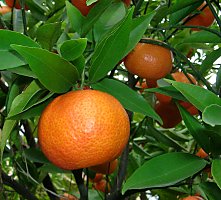|
Citrus reticulata (Mandarin, Satsuma and Tangerine)
Naartjie [Afrikaans] Life
> eukaryotes >
Archaeoplastida >
Chloroplastida
>
Charophyta > Streptophytina > Plantae (land plants)
> Tracheophyta (vascular plants) > Euphyllophyta > Lignophyta (woody plants)
> Spermatophyta (seed plants) > Angiospermae (flowering
plants) > Eudicotyledons > Core Eudicots > Rosids >
Eurosid II > Order: Sapindales > Family: Rutaceae > Genus:
Citrus
The Mandarin was probably domesticated in tropical Southeast
Asia. By 500 BC it was known in China and by 300 BC it was being grown
commercially in central China. By 400 AD, grafting methods were being used to
clone favourable varieties. It was introduced to Japan at
an early stage, and it was here that the Satsuma variety was developed. Despite
its popularity in Asia, it was only in the 1800's that Citrus
reticulata was established in Europe, North Africa, West Indies, North
and South America, and Australia.

The Mandarin was probably domesticated in tropical Southeast Asia. By 500 BC
it was known in China and by 300 BC it was being grown commercially
in central China. By 400 AD, grafting methods were being used to clone
favourable varieties. They were also using tree-nesting Taylor Ants (Oecophylla
smaragdina) to defend trees It appears that the
Mandarin has and still is the most important citrus species in China, both
commercially and in people's gardens. It was introduced to Japan at
an early stage, where it also became the most favoured of the citrus
species, and it was here that the Satsuma variety was developed. Despite
its popularity in Asia, it was only in the 1800's that Citrus
reticulata was established in Europe, North Africa, West Indies, North
and South America, and Australia.
Publications
-
Brown, D. 2002. The Royal Horticultural
Society New Encyclopedia of Herbs and their Uses. Dorling Kindersley,
London.
-
Sauer, J.D. 1993. Historical geography of
crop plants - a select roster. CRC Press, Boca Raton, Florida.
|
